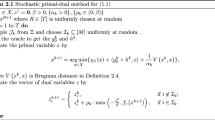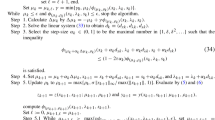Abstract
A primal - dual simplex variant is presented that incrementally builds up the optimal LPbasis matrix. For network LPs, the incremental primal - dual algorithm can adopt steepest-edgedirections of movement utilizing standard graph data structures without additionalcomputational overhead. Computational results indicate the resulting implementation isuniformly superior to other direction movement schemes, and achieves order of magnitudespeedups versus a primal network simplex code on medium size NETGEN problems. Thesespeedups carry over to the generalized network problem domain as well. Some comparisonsare also made against the relaxation method on NETGEN uncapacitated transportation andtransshipment problems.
Similar content being viewed by others
References
R. Ahuja, T. Magnanti and J. Orlin, Network Flows: Theory, Algorithms and Applications, Prentice-Hall, NJ, 1993.
R. Barr, F. Glover and D. Klingman, Enhancements of spanning tree labeling procedures for network optimization, INFOR 17(1979)16–34.
R. Barr and B. Hickman, Parallel simplex for large pure network problems: Computational testing and sources of speedup, Operations Research 42(1994)65–80.
D.P. Bertsekas and P. Tseng, Relaxation methods for minimum cost ordinary and generalized network flow problems, Operations Research 36(1988)93–114.
R. Bland, J. Cheriyan, D. Jensen and L. Ladanyi, An empirical study of min cost flow algorithms, DIMACS Series in Discrete Mathematics and Theoretical Computer Science 12(1993)110–156.
G. Bradley, G. Brown and G. Graves, Design and implementation of large scale primal transshipment algorithms, Management Science 21(1977)1–38.
G. Brown and R. McBride, Solving generalized networks, Management Science 30(1984)110–156.
N. Curet, A primal–dual simplex method for linear programs, Operations Research Letters 13(1993)233–237.
N. Curet, An incremental primal–dual method for generalized networks, Computers and Operations Research 21(1994)1051–1060.
J. Forrest and D. Goldfarb, Steepest-edge simplex algorithms for linear programming, Mathematical Programming 57(1992)341–374.
F. Glover, D. Karney and D. Klingman, Implementation and computational comparisons of primal, dual and primal–dual computer codes for minimum cost network flow problems, Networks 4 (1974)191–212.
A. Goldberg and M. Kharitonov, On implementing scaling push-relabel algorithms for the minimum-cost flow problem, DIMACS Series in Discrete Mathematics and Theoretical Computer Science 12 (1993)157–198.
D. Goldfarb, Steepest-edge simplex algorithms for network flow problems, Technical Report RC 6649, T.J. Watson Research Laboratory, IBM, 1977.
D. Goldfarb and M. Grigoriadis, An efficient steepest edge algorithm for the maximal flow problem, 10th International Symposium on Mathematical Programming, Montreal, 1979.
M. Grigoriadis, An efficient implementation of the network simplex method, Mathematical Programming Study 26(1986)83–111.
J. Kennington and R. Helgason, Algorithms for Network Programming, Wiley, New York, 1980.
D. Klingman and J. Mote, Computational analysis of large-scale pure networks, ORSA /TIMS Joint National Meeting, New Orleans, 1987.
D. Klingman, A. Napier and J. Stutz, NETGEN: A program for generating large scale capacitated assignment, transportation, and minimum cost network flow problems, Management Science 20 (1974)814–821.
I. Maros, Performance evaluation of the MINET minimum cost netflow solver, DIMACS Series in Discrete Mathematics and Theoretical Computer Science 12(1993)199–218.
J. Mulvey, Pivot strategies for primal-simplex network codes, Journal of the ACM 25(1979)266 –270.
M. Resende and G. Veiga, An efficient implementation of a network interior point method, DIMACS Series in Discrete Mathematics and Theoretical Computer Science 12(1993)299–348.
M. Schneider, A complementary pivoting algorithm for linear network problems, Annals of Operations Research 5(1986)439–462.
Rights and permissions
About this article
Cite this article
Curet, N.D. Implementation of a steepest-edge primal - dualsimplex method for network linear programs. Annals of Operations Research 81, 251–270 (1998). https://doi.org/10.1023/A:1018905123635
Issue Date:
DOI: https://doi.org/10.1023/A:1018905123635




